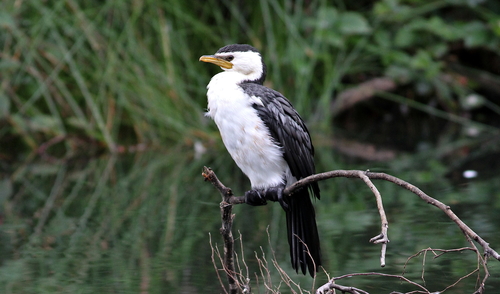
Little Pied Cormorant
The Little Pied Cormorant (*Microcarbo melanoleucos*) is a common waterbird found throughout Australasia and nearby islands. It is known for its distinctive black and white plumage, and its adaptability to a wide variety of aquatic habitats. This species plays a crucial role in its ecosystems as a predator of fish and other aquatic animals, helping to regulate prey populations. Unlike some cormorant species, the Little Pied Cormorant is often found in freshwater environments as well as coastal areas.
55-65 cm
Length
85-95 cm
Wingspan
Least Concern
Conservation Status
Distribution
The Little Pied Cormorant is found in Australia, New Zealand, New Guinea, Indonesia, and various surrounding islands in the southwestern Pacific. It has a broad altitudinal range, occurring from sea level to elevations of up to 1000 meters in some areas. It is generally non-migratory, although some localized movements may occur in response to water availability.
Lifespan
Not Evaluated, but likely similar to other cormorant species (5-15 years in the wild).
Little Pied Cormorant's Habitat
Habitat Types
Coastal waters, Estuaries, Mangrove swamps, Rivers, Lakes, Reservoirs, Farm dams, Wetlands
Climate Zones
Tropical, Subtropical, Temperate
Adaptations
This species exhibits strong adaptability to both fresh and saltwater environments. They possess a specialized nictitating membrane, a transparent third eyelid, that protects their eyes while diving underwater. They also have fully webbed feet for efficient swimming.
Variations
Three subspecies are generally recognized: *M. m. melanoleucos* (Australia, Indonesia), *M. m. brevicauda* (New Caledonia), and *M. m. brevirostris* (New Zealand).
Appearance
Breeding Plumage
Little variation between breeding and non-breeding plumage. Adults are predominantly black above and white below, with a sharp demarcation. The face is yellow.
Seasonal Feather Changes
Minimal seasonal variation.
Sex Based Plumage Differences
Males and females have similar plumage.
Notable Features
Yellow facial skin, Black upperparts and white underparts, Short, hooked bill, Fully webbed feet
Diet and Feeding
Primary Foods
Small fish, Crustaceans, Aquatic insects, Amphibians
Foraging Behavior
The Little Pied Cormorant is a pursuit diver, propelling itself underwater with its webbed feet to chase prey. It typically forages in relatively shallow water, often near the edges of water bodies or among submerged vegetation.
Specializations
Their hooked bill helps to secure slippery prey.
Seasonal Diet Variations
Diet may vary slightly depending on prey availability, which can fluctuate seasonally. For example, during periods of high rainfall, they may consume more amphibians.
Behavior
Social Structure
Little Pied Cormorants are often seen in small flocks, but can also be found singly or in pairs. They may form larger aggregations at roosting sites or abundant food sources.
Communication
Guttural croaks and grunts, Hissing sounds (especially when threatened), Visual displays (e.g., wing-waving during courtship)
Migration
Generally non-migratory, but may undertake local movements in response to changing water levels or food availability.
Territorial or Group Behaviors
They are not strongly territorial, but may defend a small area around their nest. They often roost communally, sometimes in mixed-species flocks with other cormorants or waterbirds.
Conservation
Threats
Habitat degradation (e.g., wetland drainage, pollution), Entanglement in fishing gear, Disturbance at breeding colonies, Competition with fisheries
Protection Programs
Wetland conservation and restoration initiatives, Protected area management, Awareness campaigns to reduce disturbance
Local National Laws
Protected under various state and national wildlife legislation in Australia and New Zealand.
Population Trend
Stable
Population Estimates
The global population is estimated to be in the hundreds of thousands, and the species is considered common throughout much of its range.
Interesting Facts
They often perch with their wings outstretched.
This behavior, known as 'wing-drying,' is thought to help dry their feathers, which are not as waterproof as those of some other waterbirds.
They can dive to depths of up to 10 meters.
Although they typically forage in shallower water.
The name 'cormorant' is derived from the Latin words 'corvus' (raven) and 'marinus' (of the sea).
Meaning 'sea raven'.
Faqs about Little Pied Cormorant
Are Little Pied Cormorants endangered?
No, they are classified as 'Least Concern' by the IUCN, indicating a healthy and widespread population.
What do Little Pied Cormorants eat?
They primarily eat small fish, crustaceans, aquatic insects, and amphibians, which they catch by diving underwater.
Where can I see Little Pied Cormorants?
They are commonly found near bodies of water, including coastal areas, rivers, lakes, and wetlands, throughout Australia, New Zealand, and surrounding islands.
Do they migrate?
No they are generally non-migratory birds.
Copyright @ Nature Style Limited. All Rights Reserved.
 English
English